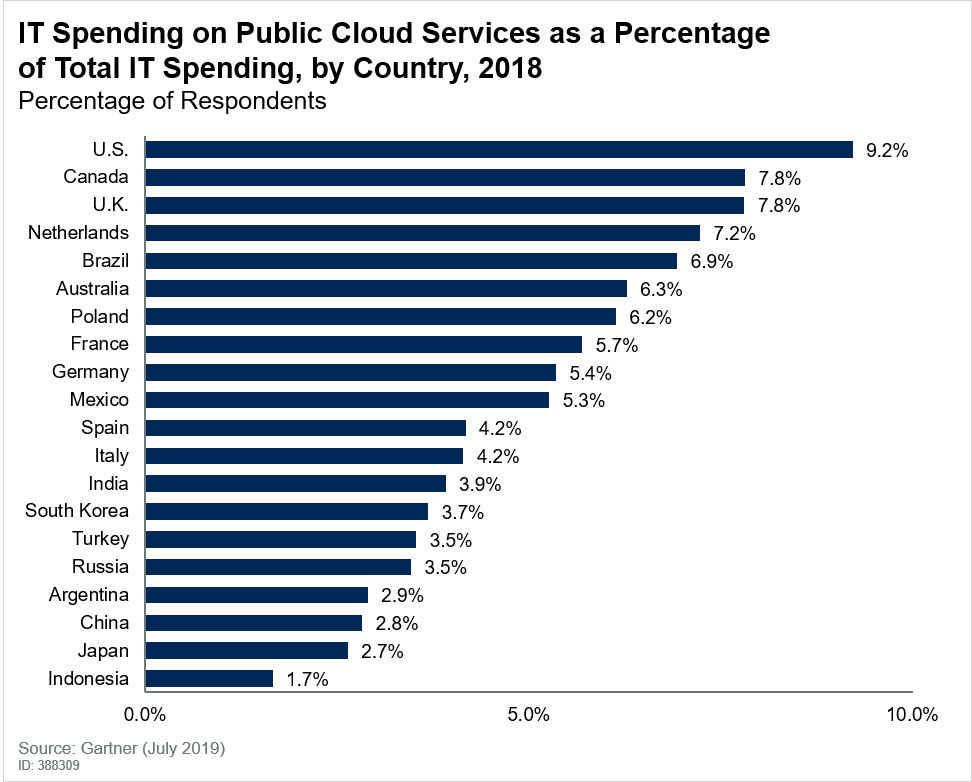 CLOUD
CLOUD
 CLOUD
CLOUD
 CLOUD
CLOUD
Cloud has become the foundation that enables businesses to transform, differentiate and gain competitive advantage. Many organizations are now focused on cloud-first strategies as they turn their attention to advancing the use of cloud services across the business. In fact, 40% of organizations in North America alone plan to spend the majority of new or additional funding on cloud, according to a recent Gartner survey.
Through 2022, growth in enterprise information technology spending for cloud-based offerings will be faster than growth in traditional, noncloud IT offerings, making cloud computing one of the most disruptive forces in IT markets since the early days of the digital age.
Cloud adoption rates predict the future use of digital technologies such as artificial intelligence, data analytics and Internet of Things solutions. The rate of IT spending on public cloud services relative to IT spending overall provides an indicator of where cloud adoption is occurring the fastest (and the slowest). It predicts the likelihood of organizations adopting next-generation digital technologies, which will almost always be based on a public cloud foundation. Organizations with a high percentage of IT spending dedicated to cloud will become the recognized digital leaders in the future.
However, despite the correlation between high cloud adoption and becoming a digital leader, IT spending on cloud still varies considerably across countries (pictured). For instance, the United States has the highest rate of IT spending on public cloud services in 2018 with cloud spending 8.9% of total IT spending, and Argentina has the lowest rate of cloud spending at 0.7%. Some countries lag behind the United States from one to seven or more years.
In 2016, the U.S. represented 57% of the global spending on public cloud services, compared with its 46% share of the global IT market. By 2022, the relative share of cloud spending in the U.S. will have dropped slightly to 54%, while its share of IT spending across all IT markets is expected to remain about 46%.
Countries with cloud spending growth rates exceeding related IT spending growth rates have the potential to close the cloud spending gap with the U.S. and potentially displace the U.S. as the cloud spending leader. Most notable of these countries is Poland. At this point Poland’s rate of IT spending on cloud is growing notably faster than Poland’s rate of IT spending generally.
There is still a group of countries that are not only lagging by seven or more years, but their respective growth rates do not put them on a path to close the gap. We refer to these countries as “resisting countries,” under which Argentina, Japan and Indonesia fall. Resisting countries are not simply lagging in cloud adoption, they are falling further behind other countries.
In these countries, cloud adoption will remain intermittent, episodic and slow until the points of cloud resistance are overcome. Obstacles such as cultural biases, technology availability and regulatory impediments all play a factor in these countries’ cloud adoption rates.
The implication for resisting countries is that they will not be positioned to adopt the next-generation innovations that are based on a cloud foundation. Most prominent among these is AI, which generally requires cloud. Countries that are slow to adopt cloud will be slow to adopt the cloud-based technologies that will be at the heart of digital disruption. So the implications can be significant indeed.
Argentina is slow because of economic factors. Moving to a new technology, such as cloud, requires new investment. If budgets are flat or down then new spending isn’t available and therefore cloud adoption is stifled.
Ed Anderson, a distinguished research vice president at Gartner, wrote this piece for SiliconANGLE. He focuses his research on the broad cloud service market, including market trends, forecasts, the cloud vendor landscape and cloud sourcing scenarios. He tracks different cloud usage cases, including public cloud, private cloud and hybrid cloud scenarios. Cloud adoption often means employing consulting, implementation, migration and managed services, and Anderson provides a perspective on the key service providers delivering these services. Anderson and other cloud experts at Gartner can be reached though katie.costello@gartner.com.
Support our mission to keep content open and free by engaging with theCUBE community. Join theCUBE’s Alumni Trust Network, where technology leaders connect, share intelligence and create opportunities.
Founded by tech visionaries John Furrier and Dave Vellante, SiliconANGLE Media has built a dynamic ecosystem of industry-leading digital media brands that reach 15+ million elite tech professionals. Our new proprietary theCUBE AI Video Cloud is breaking ground in audience interaction, leveraging theCUBEai.com neural network to help technology companies make data-driven decisions and stay at the forefront of industry conversations.